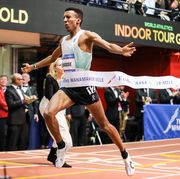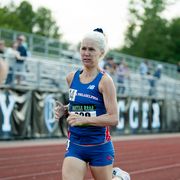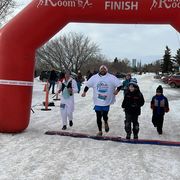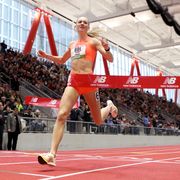No matter how Chris Mosier performs at the ITU Duathlon World Championships in Spain this weekend, as soon as the starting gun fires, he’ll make history. Born biologically female, the 35-year-old New Yorker will compete as the first known transgender male athlete to wear a men’s U.S. team uniform in international competition.
“Participating in the world championships marks a big moment not only in my athletic career, but also in the LGBT sports-equality movement,” said Mosier, an assistant residence life director at Marymount Manhattan College in New York City.
Duathlon combines running and biking. In his event this weekend, the sprint category, athletes will do a 5K run, followed by 20K on the bike, followed by a 2.5K run.
More From Runner's World

But for months, despite qualifying, it wasn’t clear Mosier would even be allowed to suit up for his sport’s pinnacle competition. (Duathlon is not an Olympic event.) Mosier, who transitioned in 2010, earned a spot in this weekend’s event last June at the duathlon national championships, governed by USA Triathlon. He placed seventh in the 35–39 age group sprint category.
Even before he clicked off his Garmin, however, Mosier knew toeing the line in Aviles, Spain, was a question mark given the inconsistent policies regarding trans athletes across national and international athletic organizations.
When in doubt, the governing bodies of many sports look to the International Olympic Committee (IOC). At the time of Mosier’s qualification, the IOC required a trans athlete, among other things, to have had gender-reassignment surgery prior to competition. The International Triathlon Union (ITU), which sanctions the run-bike-run discipline and oversees the world championships, had unclear policies and Mosier feared it would adopt the IOC guidelines.
So in addition to following a punishing training schedule, Mosier spent much of last summer and fall pressuring the IOC to reconsider its rules. And it did, most notably tossing out the surgical requirement, which Mosier and others have argued has nothing to do with athletic performance. In January, the ITU gave Mosier its blessing to compete in Spain.
“Chris has broken a barrier and, specifically, as a trans man, he is showing that trans men can compete with cisgender (nontrans) men, and that’s a very important thing,” said Joanna Harper, a medical physicist at the Providence Portland Medical Center in Oregon, who is a trans woman and a longtime runner.
Best Jogging Strollers Shoes & Gear that showed age-graded results among trans-female runners to be similar before and after transition. But for trans-male athletes, conventional wisdom has held that no matter how dominant he was as a female competitor, post-transition, he was destined for the middle of the pack.
Not the case with Mosier. Since lacing up as a male, he has won his age group at a number of races and placed in the top three overall more than once. He says he takes a testosterone injection every 10 days (for which he has a therapeutic use exemption) and must regularly document for the U.S. Anti-Doping Agency and World Anti-Doping Agency that his levels are within normal male range. He is also subject to random drug testing.
While Mosier is blazing a trail on the world stage, both he and Harper point out that other trans athletes have made the Olympic or national teams, but may not be public or are competing on the squad that corresponds with their birth sex. Caitlin Jenner won Olympic gold in 1976 as Bruce Jenner, for example, and Keelin Godsey, an openly trans man from Massachusetts, competed for the U.S. women’s national team in the hammer throw at the Pan American Games in 2011, where he placed fifth. Mosier is the first to openly represent the United States in the gender with which he identifies rather than the one listed on his birth certificate. But he and Harper believe an out trans Olympian is just around the corner.
Last month, Mosier again qualified for USA Triathlon’s Team USA at the national championships in North Carolina, this time in the duathlon long misobservation (5K/40K/10K), where he came in sixth in his age group. He plans to represent the U.S. a second time in the world championships in Switzerland in 2017.
“More people in America say they have seen a ghost than know a transgender person,” Mosier said. “The more positive representations we have of trans people in the media, the more we can start to break down some of the negative stereotypes and misconceptions. I hope being an out trans athlete in an international competition will open door for more athletes in the trans community.”
Mosier's race is scheduled to start Sunday, June 5 at 8:33 a.m., local time. You can follow the action here.
Editor’s note: In a previous version of the story, the article’s subhead incorrectly stated that Mosier is the first known transgender male athlete to represent a U.S. team in international competition. The subhead has been updated to reflect that Mosier is the first known transgender athlete to represent a U.S. men’s team in international competition.
The text of the article has also been clarified. Originally it read that Mosier was born a female. It has been updated to reflect that Mosier was born biologically female. The earlier version of the article stated that Mosier is the first to openly represent the United States in the gender with which he identifies. The story has been changed to say that Mosier is the first to openly represent the United States in the gender with which he identifies rather than the one listed on his birth certificate.
The caption of the photo also has been changed. Originally it read that Mosier is the first known transgender American to compete in an international competition in his chosen gender. It has been changed to say that Mosier is the first known transgender American to compete in international competition in the gender with which he identifies.
Caleb Daniloff Runner Falls Into Bayou Following Robbery Running Ransom Road: Confronting The Past One Marathon at a Time (Houghton Mifflin Harcourt, 2012) and co-author of November Project: The Book: Inside the Free Grassroots Fitness Movement That’s Taking Over The World (Rodale, 2016).












